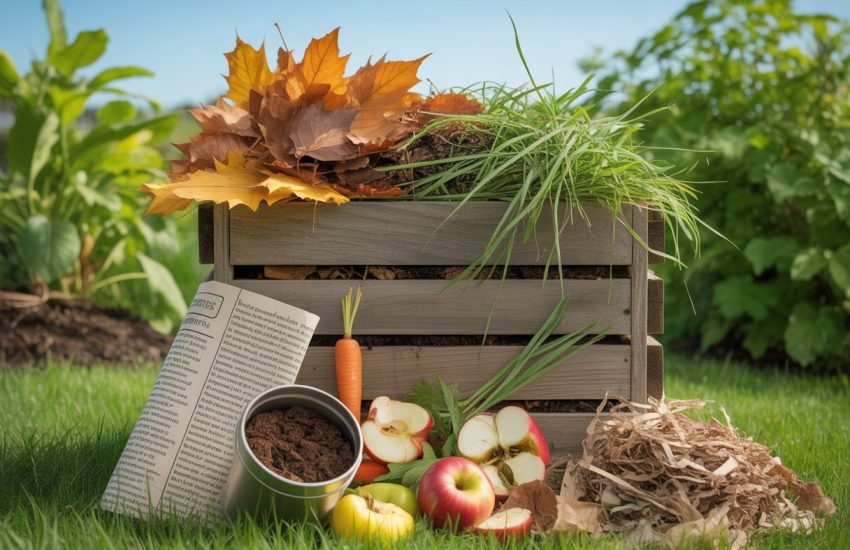Do Begonias Like Sun? A Guide to Begonia Sunlight Preferences
Begonias are a popular choice for indoor and outdoor plants due to their vibrant colors and ease of care. However, one question that often arises is whether begonias prefer direct sunlight or shade. The answer to this question is not straightforward as it depends on the specific type of begonia and its individual needs.
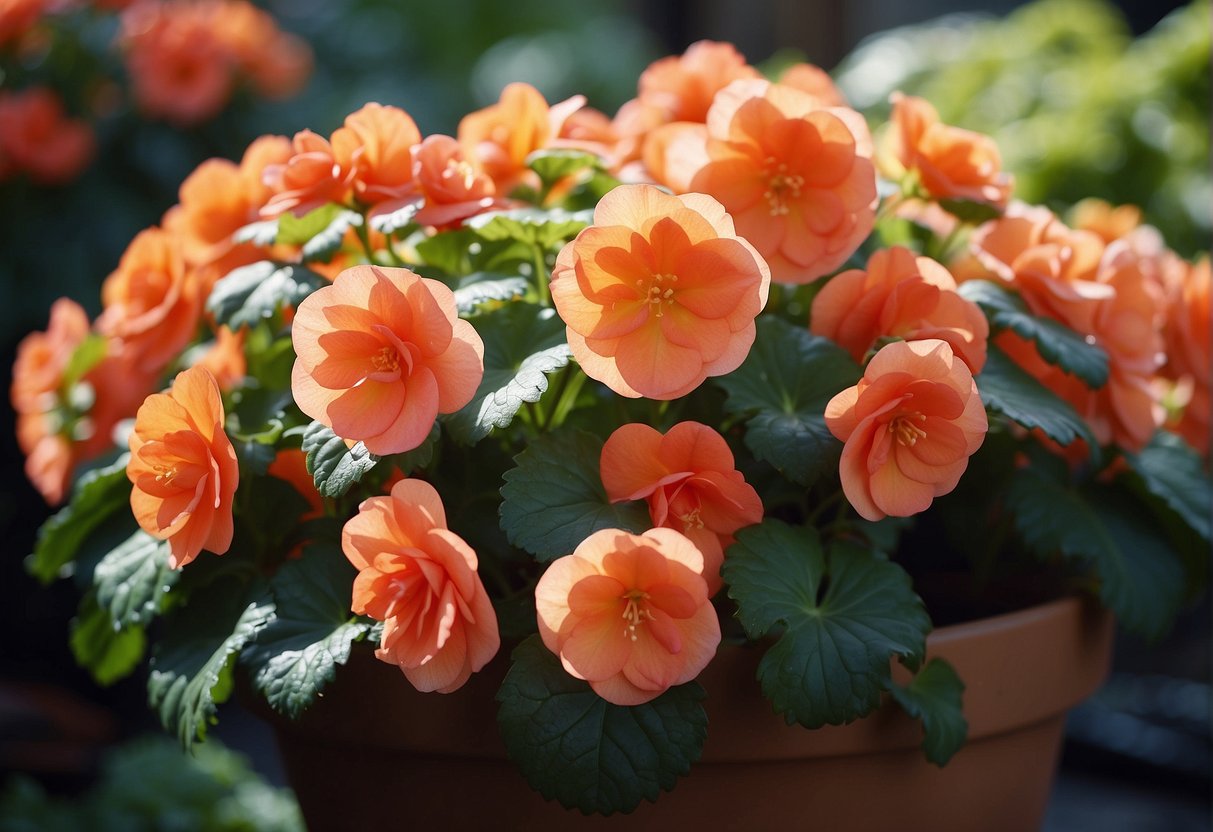
Some begonias, such as the tuberous begonia, prefer partial shade and indirect sunlight. This is because direct sunlight can scorch their leaves and cause damage to the plant. On the other hand, other varieties of begonias, such as the wax begonia, can tolerate more direct sunlight and prefer at least 4-6 hours of sunlight per day. It is important to research the specific type of begonia you have to ensure that it is receiving the appropriate amount of sunlight for optimal growth and health.
Overall, understanding the light requirements of your begonia is crucial for its care and longevity. With the right amount of sunlight, your begonia can thrive and provide a beautiful addition to your indoor or outdoor space.
Understanding Begonias and Sunlight
Begonias are a popular choice for gardeners and plant enthusiasts alike due to their stunning blooms and lush foliage. However, to keep these plants healthy and thriving, it is important to understand their light requirements.
Light Requirements for Healthy Growth
Begonias are known for their preference for partial shade to full shade conditions. In their natural habitat, they are often found growing under the canopy of trees, where they receive filtered light. In home gardens, they can be grown in areas with dappled shade or areas that receive only a few hours of direct sunlight each day.
While some begonias can tolerate full sun exposure, it is important to note that this can lead to leaf scorch and damage. Therefore, it is recommended to provide some shade or filtered light for begonias, especially during the hottest parts of the day.
Effects of Sun Exposure on Begonia Foliage
Direct sunlight can have a significant impact on the health and appearance of begonia foliage. When exposed to too much sun, leaves can turn yellow or brown and become crispy or wilted. This is due to the sun’s intense heat and UV rays, which can damage the plant’s cells and cause dehydration.
To prevent sun damage, it is recommended to provide some shade or filtered light for begonias. This can be achieved by placing them under the canopy of trees or using shade cloth or other materials to filter the sunlight.
In summary, begonias prefer partial shade to full shade conditions and can be damaged by direct sunlight. By providing some shade or filtered light, gardeners can ensure healthy growth and vibrant foliage for these beautiful plants.
Selecting the Right Location
Begonias are a popular choice for gardeners due to their vibrant colors and ease of care. However, selecting the right location for your begonias is crucial to their growth and overall health. Here are some factors to consider when choosing a location for your begonias.
Outdoor Planting and Sunlight
When planting begonias outdoors, it is important to consider the amount of sunlight they will receive. While begonias prefer partial shade, they can tolerate some direct sunlight in the morning or late afternoon. However, too much direct sunlight can cause the leaves to burn and the flowers to wilt.
If you are planting begonias in a garden, choose a location that receives morning or late afternoon sun, and shade during the hottest part of the day. If your garden does not have any shaded areas, consider planting begonias under a tree or next to a building that provides some shade.
Indoor Begonias and Light Considerations
Indoor begonias have different light requirements than outdoor begonias. They need bright, indirect light to thrive. Placing them near a window that receives morning or late afternoon sun is ideal.
If you do not have a window that provides enough light, you can supplement with artificial light. LED grow lights are a popular option for indoor gardening and can provide the necessary light for begonias to grow and thrive.
When choosing a location for your indoor begonias, also consider the temperature and humidity. Begonias prefer temperatures between 60-75°F and humidity levels of 50-60%. Avoid placing them near drafty windows or in areas with low humidity, such as near air conditioning vents.
By selecting the right location for your begonias, you can ensure they receive the proper amount of sunlight and conditions for optimal growth and health. Whether you are planting in a garden or in containers on your patio, consider the factors above to ensure your begonias thrive.
Caring for Begonias in Different Environments
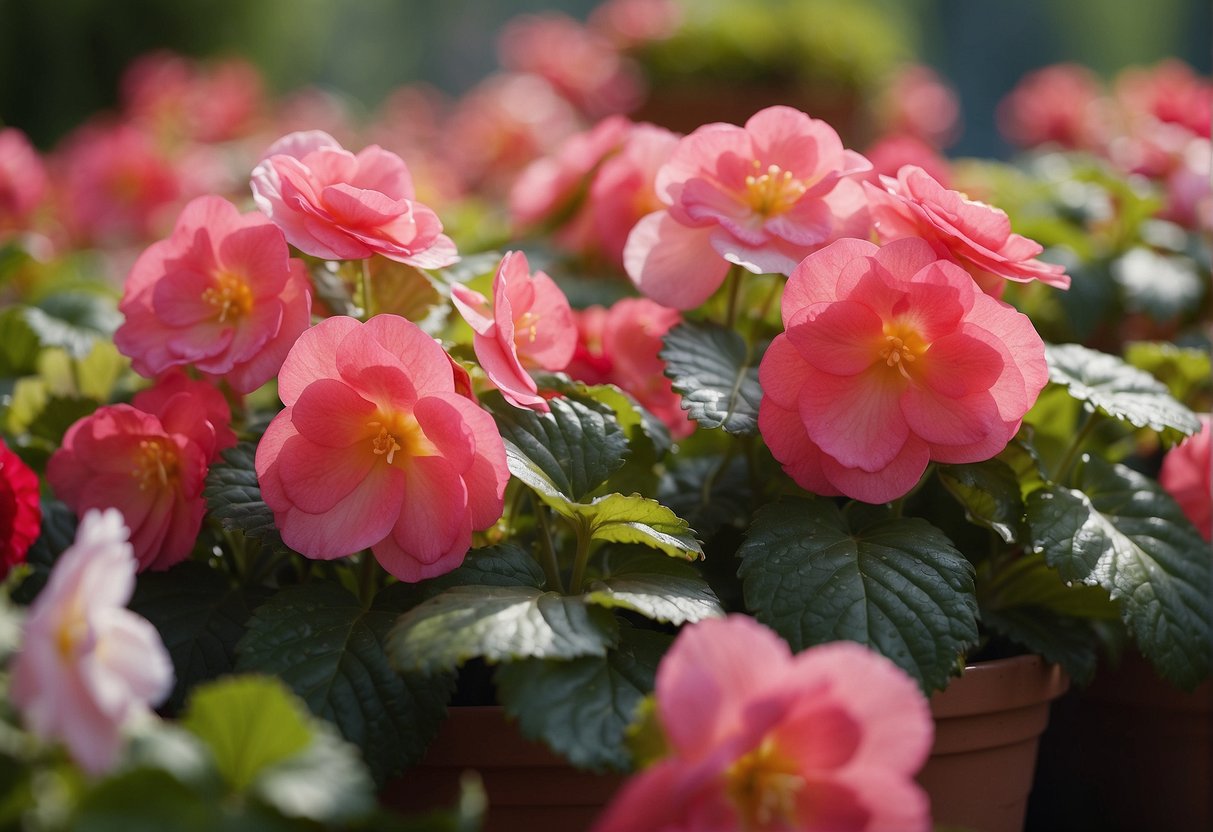
Begonias are a beautiful and popular houseplant that can thrive in a variety of environments. However, the care that they require can vary depending on the conditions they are grown in. Here are some important factors to consider when caring for begonias in different environments.
Watering and Humidity Needs
Begonias need to be watered regularly, but they do not like to sit in water. Overwatering can cause root rot, which can be fatal to the plant. To avoid this, make sure the soil is well-draining, and only water when the top inch of soil feels dry to the touch.
Humidity is also important for begonias. They prefer a humid environment, so it is a good idea to mist them regularly or place a tray of water near the plant to increase humidity.
Soil and Fertilization Practices
Begonias prefer a well-draining soil that is rich in organic matter. A potting mix that contains peat moss, perlite, and vermiculite is ideal for begonias. Fertilize the plant regularly with a balanced fertilizer to promote healthy growth and flowering.
Temperature and Seasonal Changes
Begonias prefer temperatures between 60 and 75 degrees Fahrenheit. They do not like extreme heat or cold, so it is important to keep them away from drafty windows or air conditioning vents. During the growing season, begonias should be fertilized every two weeks to promote healthy growth and flowering. In the winter, they may go dormant and require less water and fertilizer.
In conclusion, caring for begonias in different environments requires attention to watering and humidity needs, soil and fertilization practices, and temperature and seasonal changes. By following these guidelines, you can help your begonia thrive and enjoy its beautiful blooms.
Managing Pests and Diseases
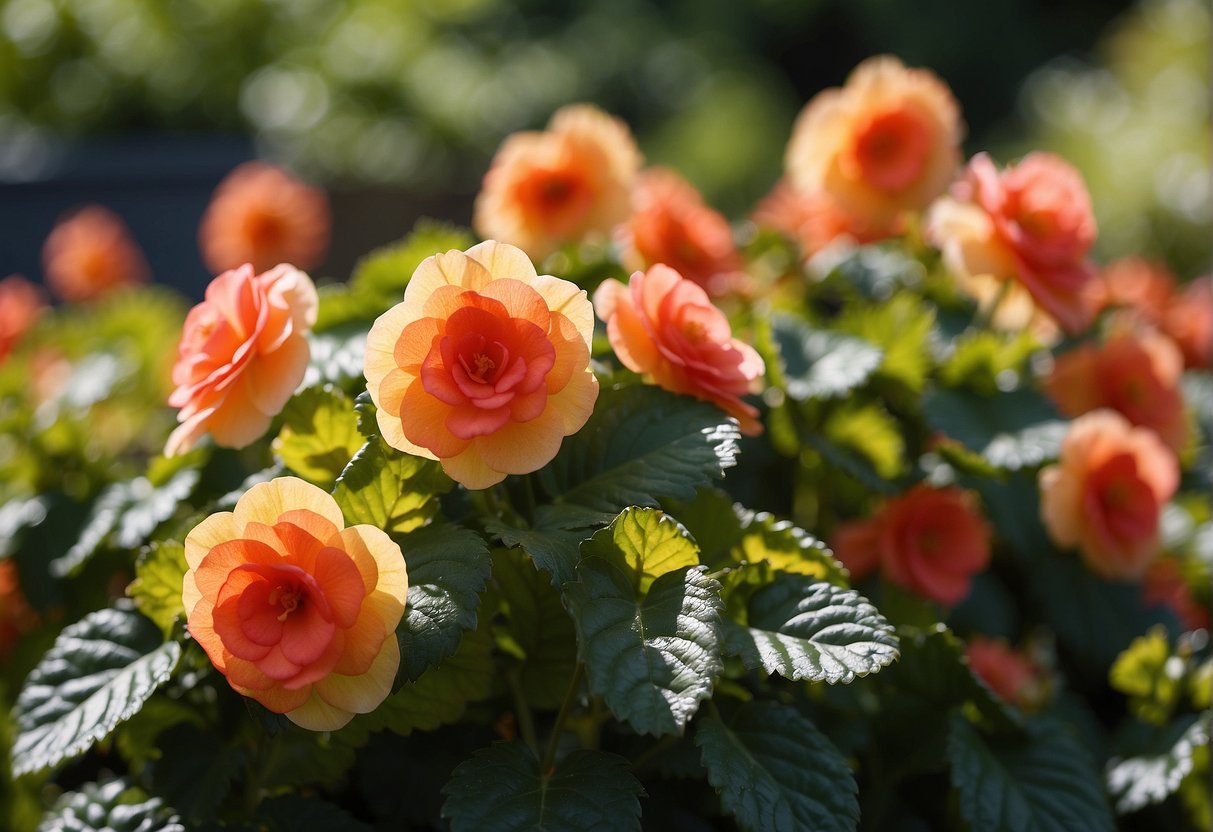
Preventing Common Begonia Diseases
Begonias are susceptible to various diseases, including mildew and rot, which can be prevented by taking proper care of the plant. One way to prevent mildew is to avoid watering the leaves of the plant, as this can create a damp environment that promotes the growth of mildew. Instead, water the soil around the plant, and make sure the soil is well-draining to avoid waterlogging.
Rot can be prevented by ensuring that the plant is not overwatered, and that any excess water is drained away. Additionally, it is important to avoid planting begonias in poorly-draining soil, as this can lead to waterlogging and rot.
Keeping Pests at Bay
Begonias can be attacked by various pests, including aphids, spider mites, and thrips. To keep pests at bay, it is important to regularly inspect the plant for signs of infestation, such as yellowing leaves or webbing.
One way to prevent pests is to keep the plant healthy and well-fed, as healthy plants are more resistant to pests. Additionally, it is important to avoid over-fertilizing the plant, as this can attract pests.
If pests are detected, there are various methods for controlling them, including using insecticidal soap or neem oil, or introducing natural predators such as ladybugs or lacewings.
Powdery mildew is another common problem that can affect begonias, and can be prevented by ensuring that the plant has good air circulation and is not overcrowded. If mildew is detected, it can be treated with fungicides or by removing affected leaves.
Cultivating Begonias for Optimal Display
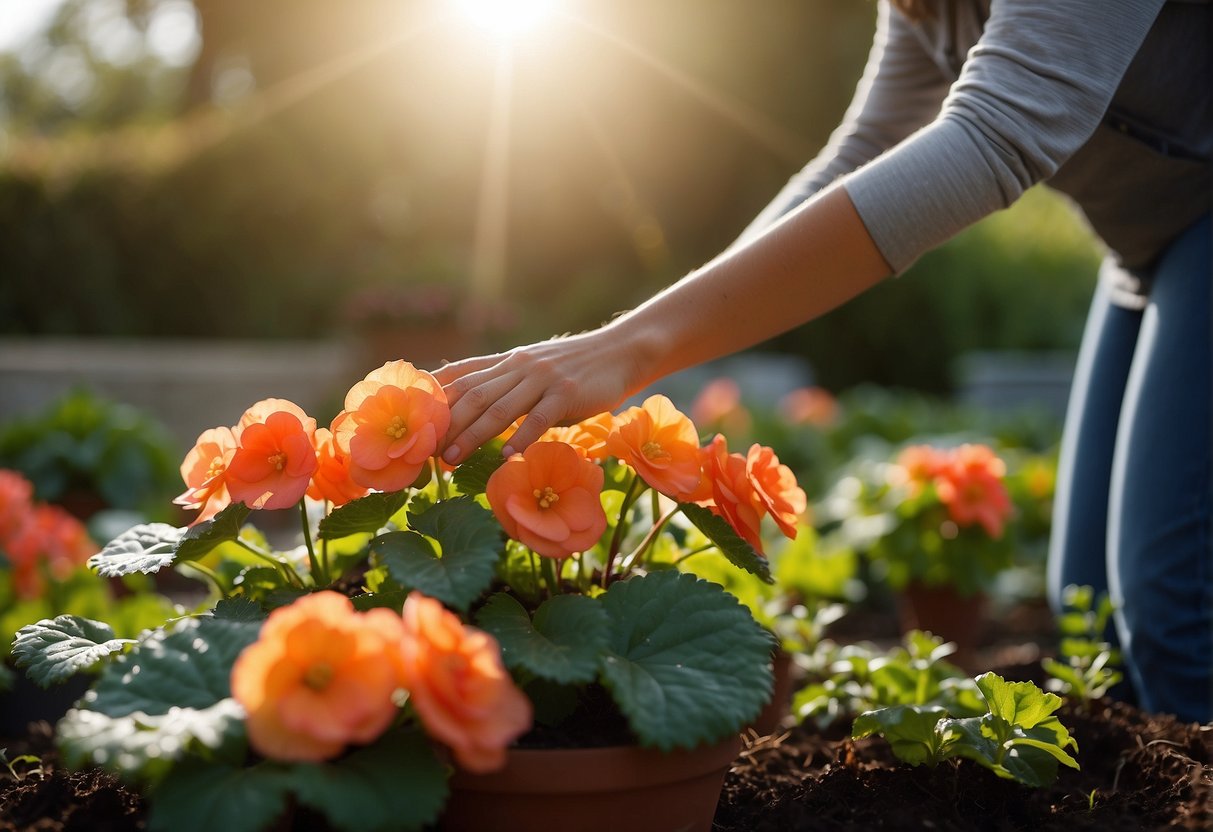
Begonias are a popular choice for gardeners looking to add a splash of color to their beds, hanging baskets, and containers. While some varieties of begonias prefer shade, others can tolerate, and even thrive, in direct sunlight. In this section, we will explore how to cultivate begonias for optimal display and discuss pruning, deadheading, and propagating techniques.
Pruning and Deadheading for Lush Blooms
Pruning and deadheading are essential for promoting lush blooms and maintaining the overall health of your begonias. Pruning involves removing any dead or damaged leaves, stems, or flowers to encourage new growth. Deadheading refers to the removal of spent blooms to encourage the plant to produce more flowers.
To prune your begonias, use a sharp pair of pruning shears to cut back any dead or damaged foliage. Be sure to make clean cuts just above a leaf node to encourage new growth. Deadheading is similarly simple – just remove any spent blooms by snipping them off at the base of the stem.
Propagating Begonias
Propagating begonias is an excellent way to expand your collection or share your love of these beautiful plants with friends and family. There are several methods of propagation, including stem cuttings, leaf cuttings, and division.
Stem cuttings are the most common method of propagation for begonias. To take a stem cutting, select a healthy stem with several leaves and make a clean cut just below a leaf node. Remove any leaves from the bottom half of the stem and dip the cut end in rooting hormone. Plant the cutting in a well-draining potting mix and keep it moist until roots form.
Leaf cuttings involve taking a healthy leaf and placing it in a potting mix with the cut end buried in the soil. Keep the soil moist, and roots should form within a few weeks. Division involves separating a mature plant into smaller sections and replanting them in new pots or garden beds.
In conclusion, cultivating begonias for optimal display requires careful attention to pruning, deadheading, and propagation techniques. By following these simple steps, you can enjoy a lush and vibrant display of begonias in your garden, hanging baskets, or containers.
Frequently Asked Questions

How much sunlight is ideal for the growth of begonias?
Begonias require moderate to bright indirect sunlight to thrive. Ideally, they should receive 4-6 hours of sunlight per day. Direct sunlight can damage the leaves and cause them to wilt or scorch.
Can begonias thrive in full sun conditions?
Begonias are shade-loving plants and cannot tolerate full sun conditions. Exposure to direct sunlight can cause their leaves to burn and reduce their growth rate. It is best to provide them with bright indirect sunlight or partial shade.
What are the consequences of exposing begonias to excessive sunlight?
Excessive sunlight can cause the leaves of begonias to turn yellow, brown or even black. It can also cause the plant to wilt and reduce its growth rate. In severe cases, the plant may die. Therefore, it is crucial to provide the right amount of sunlight to ensure the healthy growth of begonias.
Are begonias perennial plants that come back every year?
Begonias are perennial plants that can come back every year if they are provided with the right growing conditions. However, they may require some extra care during the winter months to survive.
Is it preferable to plant begonias in pots or directly in the ground?
Begonias can be planted in both pots and directly in the ground. Planting them in pots gives you more control over their growing conditions and allows you to move them around as needed. However, planting them directly in the ground can provide them with more space to grow and thrive.
Do begonias require frequent watering, and how does sunlight affect their hydration needs?
Begonias require frequent watering to keep the soil moist but not waterlogged. The amount of sunlight they receive can affect their hydration needs. In bright indirect sunlight, they may require more frequent watering, while in low light conditions, they may require less water. It is essential to monitor the soil moisture level and adjust the watering schedule accordingly.


